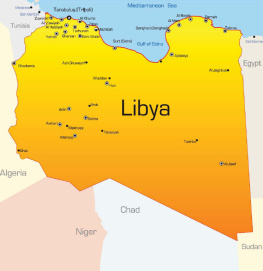Libya

A Oneworld Book
Published by Oneworld Publications 2008
This revised edition published in 2012
This ebook edition published in 2012
Copyright Ronald Bruce St John 2008, 2011
All rights reserved
Copyright under Berne Convention
A CIP record for this title is available from the British Library
ISBN 978-1-85168-919-4
Ebook ISBN 978-1-78074-082-9
Maps and Illustrations by Nathan Bailey St John
Typeset by Jayvee, Trivandrum, India
Cover design by vaguelymemorable.com
Oneworld Publications
185 Banbury Road
Oxford OX2 7AR
England
www.oneworld-publications.com
Learn more about Oneworld. Join our mailing list to find out about our latest titles and special offers at:
www.oneworld-publications.com
To Carol
PREFACE TO SECOND EDITION
Normally, a volume like this one dealing with the history of Libya from earliest times to the present might best be left unrevised. Any extensive or real improvement in detailing the history of Libya would deserve a new book. On the other hand, modern Libyan history has been dominated by Muammar al-Qaddafi and the regime he put in place after 1969; and since half the book deals with the Qaddafi era, the overthrow of the Qaddafi regime calls for an examination of why and how his forty-two-year rule came to an end.
In line with this thinking, I have left the original nine chapters largely intact, adding a tenth chapter to discuss the events surrounding the February 17 Revolution which led to the overthrow of the Qaddafi regime. In so doing, I have continued to underline the special qualities of the Libyan experience while also pointing out areas where the process of change in Libya resembled events in other economies, societies, and states. As with earlier chapters, the target audience and inherent space limitations have compelled me to focus in this new chapter on the analysis of events, providing only the detail required to make them understandable.
Chapter 10 opens with a brief look at the abortive reforms introduced by the Qaddafi regime in recent years, incomplete and ineffective efforts that set the stage for the peaceful protests that began in January 2011. It then explores why and how those largely peaceful protests demanding a better quality of life quickly turned into an armed rebellion demanding regime change. In so doing, it draws parallels with the other revolts constituting the Arab Spring which began in Tunisia in late 2010 but soon spread to Egypt and elsewhere in the region. Chapter 10 concludes with a look at the socioeconomic and political make-up of post-Qaddafi Libya.
To assist the reader in following the complex, intertwined events which have taken place in Libya in recent years, I have updated the select chronology at the beginning of the book with a focus on current events. As a number of worthwhile studies of Libya have appeared in recent years, I have also updated the bibliographical essay at the end of the book. As the reader will readily notice, most of the new material pertains to discussions and reassessments of selected aspects of the Qaddafi era (19692011), especially events over the last decade.
PREFACE TO FIRST EDITION
This book is aimed at the general reader, casual traveler, business executive, and university undergraduate student of the Great Socialist Peoples Libyan Arab Jamahiriya, generally known as Libya. It attempts to make the history of Libya understandable, interesting, and perhaps occasionally even exciting. In so doing, I have tried to provide a widely comprehensive presentation in the space available, including economic, social, and cultural as well as diplomatic and political history.
The Libyan experience, especially in modern times, has been rich and diverse, but it was not always unique. Where appropriate, I have underlined the special qualities of the Libyan experience, but I have also pointed out where the process of change in Libya shared much with that of other economies, societies, and states. Common patterns are to be expected, and within them we find Libyan particularities formed by specific contingencies.
The target audience, combined with the inherent space limitations of a general history covering more than three millennia, necessitates a book focused on the analysis of events, providing only enough detail to make them understandable. In the process, I make liberal use of my own research on Libya which spans a period of four decades. I also rely heavily on the research of others, bringing to the general reader the results of wonderfully detailed research previously accessible only to the specialist. Because of this approach, students of Libya may find some of what I say familiar, in part because Ive drawn from their work and in part because Ive repeated or expanded upon things Ive said in my own.
For those interested in further reading, the bibliographical essay at the end of the book provides a road map to the most important literature available on Libya. Given the anticipated audience, only English-language books, with a few exceptions, are cited. In addition to the individual bibliographies listed at the beginning of the essay, all of the books cited therein contain a substantial bibliography, often involving works in languages other than English, and provide those interested with a springboard for further reading. For additional detail, the reader is referred to the latest edition of my Historical Dictionary of Libya (2006) which includes the most extensive bibliography of Libya available today, listed by subject to facilitate the location of desired materials.
A very large number of people, in and out of Libya, have encouraged and assisted my research and writing over the many years. I will not try to name them as that would take far too much space; however, I do want to acknowledge their generosity and support. I also want to thank our son, Nathan Bailey St John, for illustrating this book. The illustrations and maps he has created add much to our understanding of the history of Libya. I would also like to thank my wife, Carol, to whom this volume is dedicated, for her encouragement and support over a lifetime together.
MAPS AND ILLUSTRATIONS
NOTE ON TRANSLITERATION
The transliteration of personal and place names from Arabic into English is widely recognized as a frustrating and imprecise exercise. It is made more difficult when it involves source materials stretching over three millennia and drawing on both European and non-European languages. This is particularly true in the case of Libya where the Latin spelling of personal and place names has not been standardized. On the contrary, early explorers, travelers, diplomats, and other officials, most of whom were not linguists, too often fixed the spelling of Arabic names and places in the Latin alphabet. As a result, many of the Latin spellings in use are a mixture of English, Italian, and French adaptations.
The issue of place names is an especially difficult one. To call places what they were called in the past is to invite confusion for modern readers. The past names have often disappeared completely from the memory of all but a few specialists in the area or subject. The use of past names would be historically accurate but overly confusing for the general reader. Therefore, in this text, I have preferred to refer to places according to general international usage, employing conventional, contemporary spellings whenever possible. When it is not possible, I try to make clear the connection between ancient and contemporary place names.
The convention for place names adopted in this book has the advantage of clarity, but it is not intended to endorse necessarily the policies of the people who changed the names. That said, it should enable students of Libya to consult standard international atlases and maps and easily find the places mentioned in the book.












